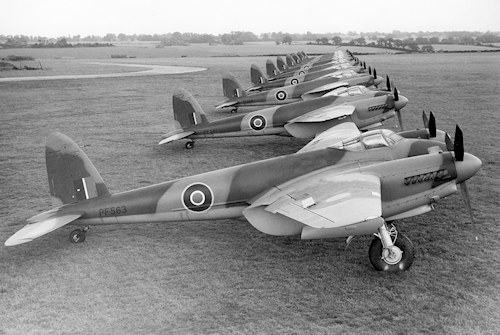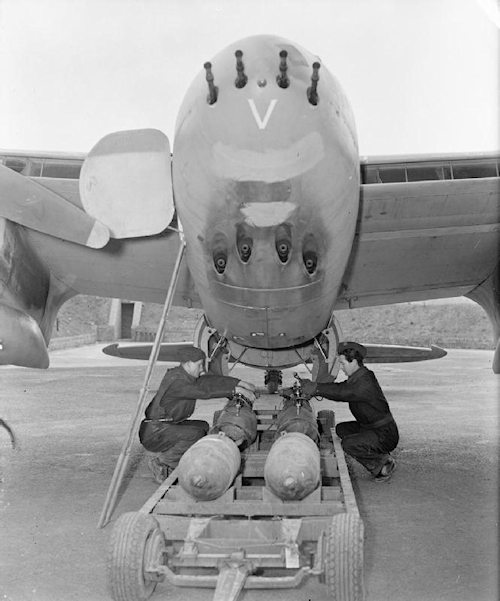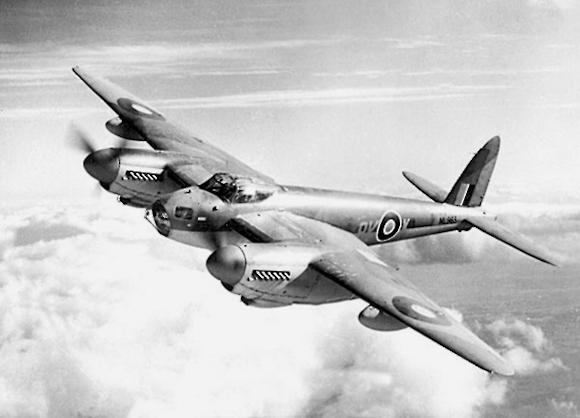Il de Havilland DH.98 Mosquito (mosquito) was one of the most important Royal Air Force aircraft active in the Second World War. Furthermore, the aircraft was almost as versatile as it was Junkers Ju 88 (see article "Luftwaffe aircraft: the Junkers Ju 88")
Il Mosquito it was used as a light bomber, fighter-bomber, night fighter, attack aircraft, reconnaissance aircraft and pathfinder. The “mosquito” was also intended for civilian use. The main users of the vehicle were the Royal Air Force, the Royal Canadian Air Force, the Royal Australian Air Force and the United States Army Air Force.
The aircraft was produced from 1940 to 1950, and nearly 8000 examples were made. The British used the medium until the early XNUMXs.
The twin-engine plane was built by the de Havilland Aircraft Company; the first prototype took to the skies for the first time on 25 November 1940 piloted by Geoffrey de Havilland Jr (achieving good results), and entered active service in November 1941. At that time it was one of the fastest active aircraft in the world.
It is worth pointing out that in the original plan the Mosquito it had to be an unarmed bomber with a speed superior to that of fighters!

Despite the good evidence of the vehicle, the political-military leaders of the United Kingdom initially had many doubts. Following battle of england, an initial order of 20 bombers and 30 fighters was placed.
Eventually, during the war the Mosquito it turned out to be an excellent tool. As previously mentioned, the twin-engine aircraft was built in large numbers and numerous variants were produced.
It is worth underlining that the aircraft was equipped with extraordinary speed, capable of escaping enemy fighters. Furthermore, the most advanced series were equipped with pressurized cabins and all were equipped with innovative instrumentation.1
During the conflict i Mosquito, as pure fighters, they served above all as night interceptors on the soil of the United Kingdom, where they were able to "knock out" a fair number of bombers and V1 flying bombs (Fieseler Fi 103) of the Third Reich.
As a bomber, the aircraft failed to match the remarkable achievements of the heavy four-engined aircraft. However, the vehicle was capable of carrying a 4000 lb (1800 kg) “Blockbuster bomb”.
 Excellent results i Mosquito they obtained them as fighter-bombers, and they were often chosen to carry out "special" raids. In this regard, noteworthy was theOperation Jericho of 18 February 1944 in Amiens, France. In that action two “mosquitoes” and two Hawker typhoon they were lost.
Excellent results i Mosquito they obtained them as fighter-bombers, and they were often chosen to carry out "special" raids. In this regard, noteworthy was theOperation Jericho of 18 February 1944 in Amiens, France. In that action two “mosquitoes” and two Hawker typhoon they were lost.
The “sector” in which – most likely – i Mosquito they were sublime, it was that of the explorers. In fact, on the darkest nights, "thanks to the experience of the pilots and the very modern instruments at their disposal, they precisely placed the special incendiary bombs to signal the targets, so the strategic bombers could then intervene safely".2
During the war, the twin-engine aircraft was used on the Western Front, in the Mediterranean, in the Middle East, in Italy and in the Asia-Pacific.
Il de Havilland DH.98 Mosquito (B Mk.XVI) had a wingspan of 16,51 m, height 5,31 m and length 13,56 m. The empty weight was 6486 kg, while loaded 8210 kg.
Engine: 2 Rolls-Royce Merlin V-12, power 1710 HP. The maximum speed was 668 km/h at 8500 m and the ceiling altitude was 11000 m.
The armament consisted of 4 7,7 mm Browning machine guns and 4 20 mm Hispano cannons. Furthermore, the vehicle could carry up to 1800 kg of bombs.
Il Mosquito it could count on a crew of 2 men.
1 See G. Bonacina, The Mosquito, in Illustrated History n°149, 1970, p.118.
2 Ibidem
Photo: RAF/web












